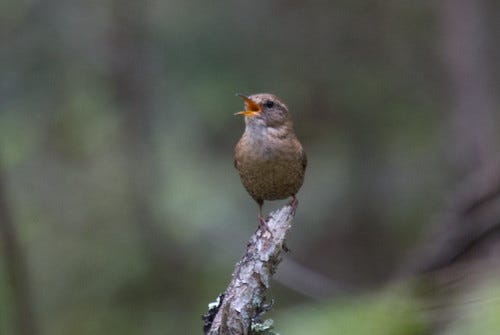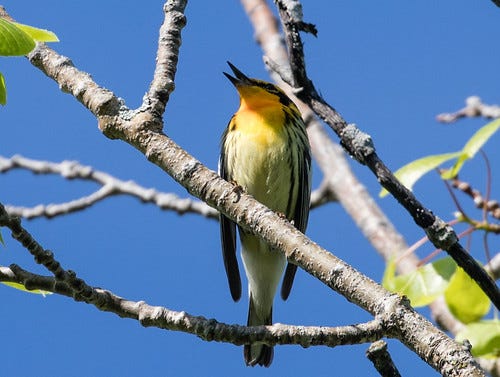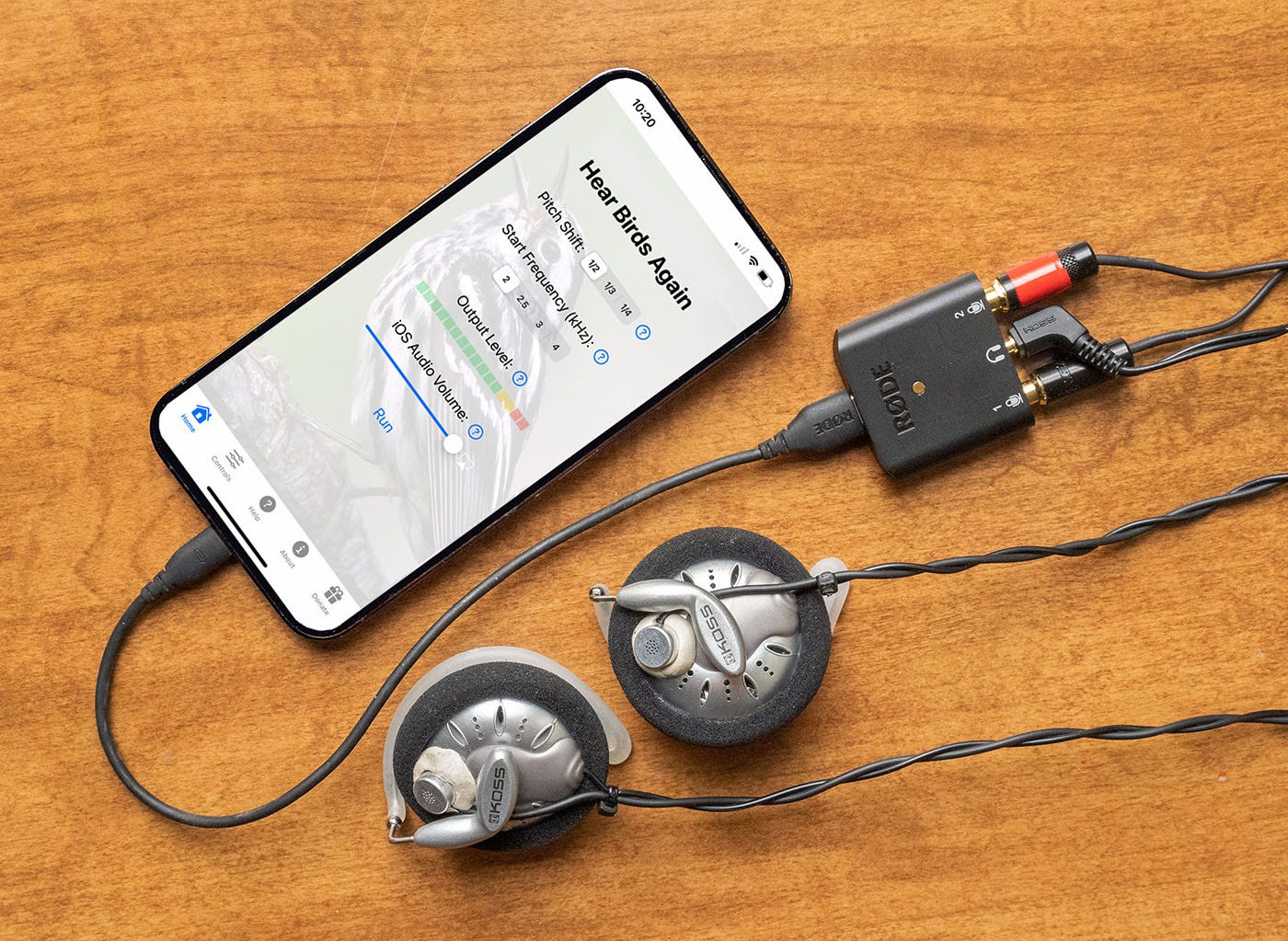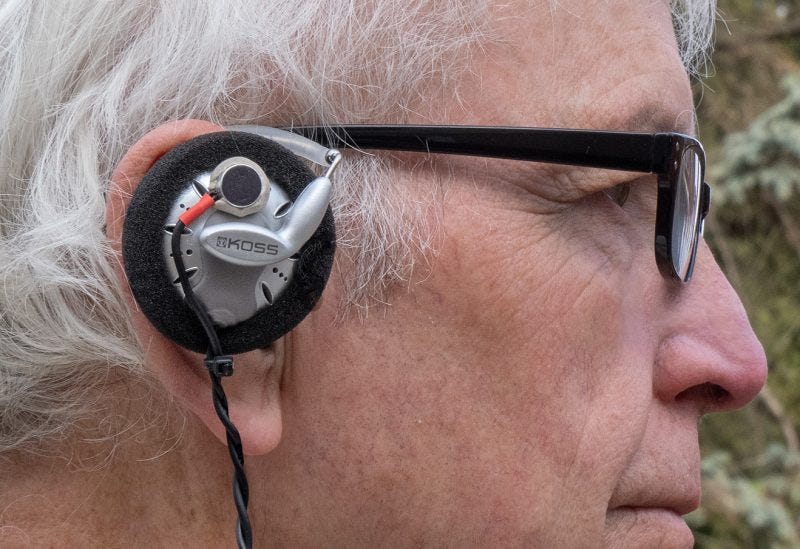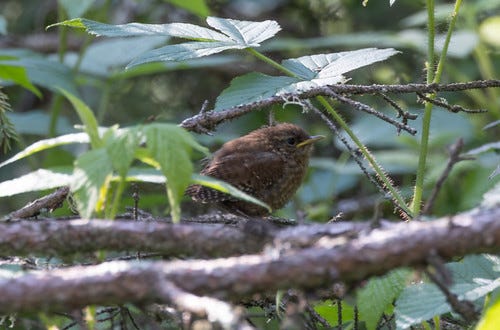(Listen to the radio version here.)
My favorite bird is the Black-capped Chickadee, but the Winter Wren and Hermit Thrush sing my favorite bird songs. Hearing either instantly captures my heart in the way that my babies’ and baby grandson’s first smiles captured it, or when Walter takes my hand in his when we’re on a walk—pure, visceral pleasure. Or as National Geographic’s “Extraordinary Birder” Christian Cooper would say, “Fantabulous!”
I’m losing my high-frequency hearing but can still hear Winter Wren and Hermit Thrush songs on recordings and in the wild as long as they’re very close by. I’ve entirely lost Blackburnian Warblers and most Golden-crowned Kinglet songs in the wild—even at close range, I’ve sometimes watched them singing without my hearing a note.
When I’m alone, I can tell exactly what birds I’m missing by using the Cornell Lab of Ornithology’s Merlin app, which I love. As each bird pipes in, the app highlights its name, so people hearing unfamiliar songs can tease out which songs belong to which birds. But as many times as Merlin might highlight that singing Blackburnian Warbler, it can’t tell me what direction the sound is coming from. And as sophisticated as Merlin is with the songs of adult birds, it doesn’t yet have in its algorithm the begging calls of most fledglings.
My hearing used to be way above average—on Big Days, I was often the first person on my team to hear that Cape May or Blackpoll Warbler. My ears have always been the tools I rely on to detect and find birds, and Merlin has been proving that I’ve been missing a lot of birds in recent years. Like climate change, the problem may have started creeping up slowly, but now is growing exponentially year after year. Unlike climate change, my hearing loss has a simple solution for listening to and finding birds again, devised by real life hero Lang Elliott.
I tested it on the Fourth of July weekend when I went birding in the Sax-Zim Bog twice—on Saturday with Erik Bruhnke and on Monday with Paula Lozano. Both times, we took a walk along the Bob Russell Memorial Bog Boardwalk in the Winterberry Bog. Both times Winter Wrens and Hermit Thrushes were singing away, and I could hear even distant ones perfectly well. I also heard Blackburnian Warblers and Golden-crowned Kinglets easy as pie! Best of all, both times I found baby Winter Wrens making extremely high frequency begging notes.
I posted a sound recording of the baby wrens, but have to wear air pods set at maximum volume to hear them despite the fact that those begging calls are the loudest sounds on the recording.

With my EarPods, the background bird songs are very audible while the baby wrens are extremely faint, but to my son Tom’s ears, even at a distance from the computer speakers, the begging calls are very easy to hear and are, indeed, louder than the other songs. So how could I possibly have heard them by myself out on the boardwalk and point my microphone directly toward them when the wrens were much further away, with so many competing sounds?
I was wearing a special binaural headset—over-the-ear headphones with a tiny microphone attached to each. The headset plugs into my iPhone to interface with a free app developed by Lang Elliott called, appropriately, Hear Birds Again.
Without this great device, I’d never have heard the baby wrens at all, much less been able to locate them to watch one of the parents fly in to feed them. I’d also have missed the singing kinglets and Blackburnian Warblers both mornings.
Hear Birds Again is a free, open-source IOS app available on the non-profit hearbirdsagain.org website. The source code is available for developers who may help improve the existing app or use the code in their own productions, to share freely to encourage continued development of more evolved solutions.
The Hear Birds Again app lowers the frequency of high frequency sounds without altering lower ones, and it’s customizable, with four settings for pitch level, so you can set it to lower just the highest sounds—those above 4 kHz—or just the sounds above 3, 2.5, or 2 kHz. You can also customize the pitch shift with three settings, lowering pitches an octave, an octave and a fifth, or two octaves.
Without the headset, the app lowers the sounds coming into the iPhone’s internal microphone and plays them back with the phone’s built-in speaker, but that isn’t very helpful when we can use the free Merlin app—it cuts to the chase and identifies the bird sounds directly. To be useful, Hear Birds Again requires a binaural headset which overrides both the iPhone’s internal microphone and speaker. At this point, there is no good ready-to-use headset, but a U.K. company sells a kit to make it yourself. After I got mine, I didn’t put it together right away—dealing with wires and tiny components seemed overwhelming. But Lang Elliott is a real hero—he put together simple, straightforward videos showing every step. It took less than an hour from my opening the packages and turning on his videos until I had my perfect headset.
With the tiny microphone attached to each earpiece, I don’t just hear those high frequency sounds—my brain calculates the direction each sound is coming from just as my ears do when listening to sounds within my normal hearing range.
The earpieces are over-the-ear, allowing the lower sounds not modified by the app to come through naturally, including human speech. Most of our consonant sounds are higher pitched than our vowels, which is why people with hearing loss often think their hearing is just fine but people are mumbling—the volume of the lower-pitched vowels sounds like it always did but the higher-pitched consonants start dropping out. With my settings, the only consonant altered by my headphones is the s-sound, especially my own (a speech-therapist friend told me I have an aspirated s-sound). Otherwise, people’s voices come through naturally, as do a great many bird songs, from Rose-breasted Grosbeaks to Pileated Woodpeckers.
Once you have the headset, how will you know which settings to use? I played bird recordings on my computer with the headset on while trying each of the settings until I settled on the ones that allow me to hear as much as I can naturally while getting the high-pitched ones I can’t hear naturally through the ear pieces.
It takes a bit of practice to recognize even the most familiar bird songs when the frequency is modified. I grasped many sounds intuitively, such as the simple hiss of LeConte’s Sparrow or the two-part Nashville Warbler. Others were trickier for me. Listening to bird recordings with the headset on will make identifying those sounds easier.
With shipping, I paid $161 for the binaural headphone kit including the recommended Koss headphones. Compared to hearing aids that cost thousands of dollars and can’t help me with the highest frequency sounds anymore anyway, that is a real bargain. Lang Elliott’s wonderful Hear Birds Again is like a miracle for me, and I don’t use the word miracle lightly. Thanks to them, I heard and saw baby Winter Wrens for the first time in my life. Yep, as Christian Cooper would put it, Fantabulous!
Lang Elliott recently talked with Nate Swick on the American Birding Association’s podcast. You can listen to it here.





